
How to manage risks in tourism?
Knowing how to manage risks and crises in tourism is vital for tour operators. Crises often occur when they are least expected, and it is important to have a risk management plan in place before anything happens. A clear process should be followed so every stakeholder knows what it involves. Mitigation, preparedness, response and recovery are the four steps that need to be taken to successfully manage crises while they are underway.
Contents of this page
1. Know what a crisis and what risk management is
Risk management is how organisations respond to and manage crises and problems. ‘Crises’ are defined as times of difficulty or danger. During these times, difficult and challenging business decisions must be made. If you have a plan in place that outlines how crises should be managed, you can adapt more easily and reduce their negative effects.
Crises can take many forms. They can be health threats, like the 2020 COVID-19 global pandemic, natural disasters, like earthquakes and floods, political unrest or terrorist attacks. Risks and crises pose significant threats to the tourism industry, destinations and tour operators.
Crises can have long term negative effects on destinations, both in terms of their image and visitor numbers. Crises can mean that tourism entrepreneurs lose money or even go bankrupt. It is important to be prepared so you can survive them. Planning how to manage risks when a crisis occurs and dealing with the issues that arise from unforeseen events are the best ways to minimise negative effects on your business.
Here are some examples of major crises that have had a significant impact on the tourism industry over the years.
Table 1: Crises that have affected the tourism industry over the years
| Crisis | Countries affected | Year | Type |
| Israel-Palestine war | Israel, Palestine | 2023, ongoing | Political instability and war |
| COVID-19 pandemic | Global | 2019–2021 | Health crisis |
| Easter Day Bombings | Sri Lanka | 2019 | Terrorism |
| Hurricane Maria in Puerto Rico | Puerto Rico, Dominica | 2017 | Natural disaster |
| Shooting in a tourist hotel | Tunisia | 2015 | Terrorism |
| Earthquake | Nepal | 2015 | Natural disaster |
| Ebola epidemic | DRC, Gabon, Congo, Sudan, Uganda, Guinea, Liberia, Sierra Leone | 2014–2016 | Health crisis |
| Eruption of Eyjafjallajökull volcano | Iceland | 2011 | Natural disaster |
| Swine flu pandemic | Mexico, USA and others | 2009 | Health crisis |
| Global economic crisis | Global | 2007/2008 | Economic crisis |
| Boxing Day tsunami in Indian Ocean | Indonesia, Sri Lanka, Maldives, Thailand | 2004 | Natural disaster |
| SARS pandemic | China, Hong Kong, Thailand, Vietnam | 2002/2003 | Health crisis |
| Bali bombings | Indonesia | 2002, 2005 | Terrorism |
| Luxor terrorist attacks | Egypt | 1997 | Terrorism |
Source: Acorn Tourism Consulting, 2024
It is important to understand that crises in tourism are not all major (macro) crises like the ones shown above. Crises in tourism also include those at a local (micro) level. They include accidents and incidents that lead to harm or the death and kidnapping of tourists, thefts, technical failures, local political unrest that affects travellers’ plans as well as other unexpected events.
In practice, this means a tourist involved in an accident while on one of your tours is significantly more important to you and your business than a natural disaster that happens thousands of miles away. However, the process to prepare for a crisis remains the same.
It is good to remember that tourism is resilient. There is a lot of evidence that shows tourists are keen to travel again to areas affected once the disaster has passed. Tourism’s recovery post-COVID is a good example. Although it has been slow, international tourism is set to fully recover by the end of 2024.
Destinations and operators that have prepared well and put good strategies in place to manage crises will be best placed to survive it and reassure tourists that it is safe to visit once again.
Crisis Example 1. Nepal earthquake response

Source: Sebastian Pena Lembarri at Unsplash, 2018
Nepal suffered from a devastating earthquake in 2015, where 9,000 people died, and more than 600,000 structures in Kathmandu and nearby towns and villages were damaged or destroyed, including 800 monuments. The country suffered from considerable negative international reporting, and tourist arrivals fell by more than a third in a year: from 790,000 in 2014 to 539,000 in 2015.
However, a social media campaign was quickly launched by the Nepal Tourism Recovery action group to address the many negative stories circulating on the Internet. The campaign encouraged international visitors to Nepal to post images of themselves holding placards featuring the slogan ‘I AM IN NEPAL NOW’.
An accompanying website featured details of the campaign and ran positive stories that helped stimulate tourism growth. By the end of 2018, tourist arrivals exceeded one million for the first time, and the country welcomed 1.2 million arrivals.
2. Have a Risk Management Process in place
Preparing for unforeseen crises is an essential element of business planning. You should do this at a time when there is no crisis so you are prepared.
Preparing for risk or crisis situations is known as a Risk Management Process. The point of Risk Management Processes is to reduce the uncertainties surrounding the actions to take during a crisis. Doing this in advance helps to prepare for unexpected events that may or may not happen. Following the five steps below will help you to minimise losses and take advantage of any opportunities that may arise.
Figure 1: The five steps of the Risk Management Process
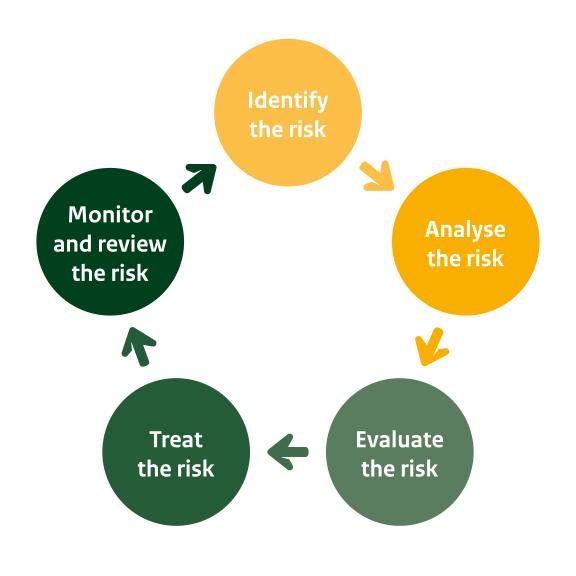
Source: Acorn Tourism Consulting, 2024
Identify the risk
No two crises are the same, and some destinations are more likely to be affected by particular crises than others. You should carry out a risk analysis. Make a list of crises that might happen based on the ones that have occurred in your region or country in the past and that may happen again. Consider risks at different levels:
- Macro events are global and you have no influence over them, like COVID-19.
- Meso events in which your influence is limited. They might be national in nature, like a political or terrorist attack.
- Micro crises are localised and likely require action within your business, like an accident sustained by a tourist on one of your trips.
Include any events that could occur based on your knowledge of your destination and other factors.
Examples include:
- Natural disasters – these include earthquakes, volcanic eruptions, tsunamis and floods, hurricanes and other extreme weather disasters.
- Political issues – political unrest is common in developing countries, and it often affects tourism. Ecuador and Peru are current examples of countries undergoing notable political instability, along with regions in Ethiopia.
- Terrorism – some countries and regions suffer more from terrorist attacks than others.
- Health-related incidents – pandemics and epidemics are the most common crises. Alongside COVID-19, the Ebola epidemic between 2014 and 2016 that affected several West African countries is a major example in this category. The Ebola epidemic affected tourism elsewhere in Africa, in countries many thousands of miles away, owing to the misconception that ‘Ebola was in Africa, so Africa has Ebola’. In 2014, the Kenya Tourism Federation reported that tourism arrivals fell by an estimated 15–20%, and hotel bookings in Tanzania dropped by up to 40%.
- Economic crises – financial crises often have a significant effect on the tourism industry, such as the Global Economic Crisis in 2008/9 that led to a 4% fall in international tourist arrivals. However, by 2010, tourism had rebounded strongly. The current cost of living crisis is affecting most European countries. Many European travellers are carefully considering what they can afford to spend on travel which, in turn, may affect your business.
- Micro crises – these are problems that could affect your business. They include accidents, technical failures, theft of tourist belongings, issues between staff/contractors and tourists, and localised disasters like flooding, fires and mudslides.
Tips:
- Review crises that have affected your business in the past and others that happened locally, regardless of whether your business was affected. Contact your tourist board to see if they have any records. Identify what was learned from the crises, no matter how small.
- Check historical records to identify other crises that happened in your area. The National Archives in your country may be a good start, or you could visit a library. Alternatively, you could do an online search using phrases like, ‘recent crisis in …’, ‘latest earthquake in…’ and so on.
- Consult experts to build your knowledge of how a particular crisis affected your destination. Check the different elements that were affected by the crisis, such as the environment, infrastructure, facilities and the economy.
- Build a scenario around ‘What if it happened here/now?’. Involve and discuss it with your staff to explore all possible scenarios and develop alternative solutions. Read the article How to Compose Crisis Scenarios to help you build crisis scenarios.
Analyse the risk
Analysing risks involves deciding how likely it is that a crisis will occur. It also involves identifying the risk of potential consequences from insignificant to catastrophic. Understanding the crises that will have the most negative impact will enable you to decide on the priority course of action. For each risk you identify, create a matrix like the one below that assesses and rates the likelihood of the event happening and the possible consequences.
Figure 2: Risk assessment matrix
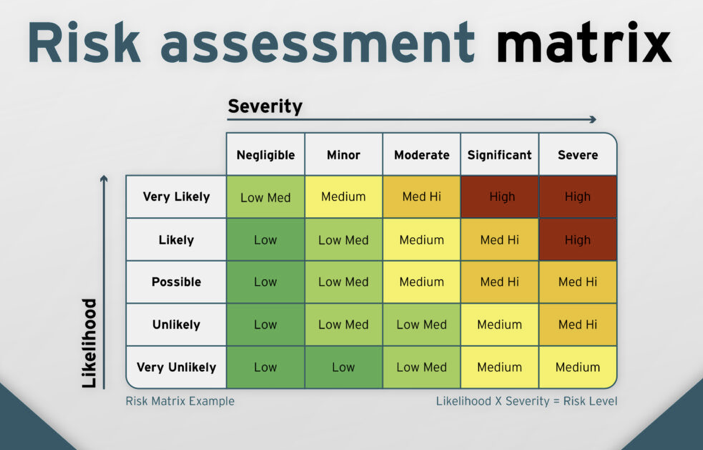
Source: Riskpal, 2023
You can download matrix templates from the internet or make your own using an Excel spreadsheet.
Evaluate the risk
Once risks have been analysed, they need to be ranked and prioritised. For instance, a risk that causes minor inconvenience is rated as low priority. However, a risk that can result in a catastrophe must be dealt with quickly. Evaluating risks is an important task as it will allow you to view the risk exposure of the whole business.
Treat the risks
There are a number of strategies that you can adopt to manage risks. These are:
- Avoid the risk – this involves not proceeding with an activity likely to be risky. For instance, if a tour operates in an area prone to flooding or landslides at a particular time of year, the tour may be automatically discontinued at this time or be re-routed.
- Reduce the risk – if a risk cannot be eliminated completely, then steps should be taken to reduce it by implementing initiatives like suitable safety standards or providing suitable equipment.
- Transfer the risk – usually to a third party such as an insurance company. At the very minimum, your business should have public liability and professional liability coverage. European tour operators generally require their suppliers to have adequate liability insurance in place before doing business with them. See the tips below for more information.
- Retain the risk – this typically refers to accepting that minor risks do sometimes happen in the course of business and being able to manage them in the most appropriate way.
How European adventure tourism operators manage risk
Managing risk is a crucial factor for adventure tourism operators as they have to ensure the safety of their customers. They usually have extensive liability insurance coverage to protect them and their customers. Many European tour operators also comply with international adventure tourism standards to provide their travellers with assurance.
The two most common standards on the market are the International Organisation for Standardisation’s (ISO) standard for adventure management and the British Standard for Adventure Tourism.
Tips:
- To find out more about European buyers’ requirements, download the CBI study What are the requirements for tourism services in the European market.
- Investigate what level of insurance coverage you currently have for your business. Check your levels of cover in case of crises. Premiums tend to increase the more coverage you have. Once you have analysed and evaluated potential risks, you can make a judgement about business insurance requirements. Some insurance companies offer support in creating crisis management plans and undertaking risk assessments. For instance, the SATIB provides insurance for tour operators throughout southern Africa.
- Read more about managing risk in the European adventure tourism market in the CBI study Entering the European market for Adventure Tourism.
- Consider complying with one or both of the adventure standards indicated to provide your European buyers with assurance.
Crisis Example 2. Easter Sunday Bombings in Sri Lanka in 2019

Source: Randika Premaratne , 2020
The Easter Sunday bombings in Sri Lanka in 2019 saw a 70% fall in tourist arrivals during the following weeks. However, the crisis also sparked a wave of interest on the internet, and the phrase ‘where is Sri Lanka’ became a top trending search term in Google. Within a month of the crisis, the government began working with a team of crisis management experts. Three agencies were merged to become ‘Sri Lanka Tourism’, and a robust marketing strategy was developed to help put Sri Lanka back on the global travel map. Source markets were analysed and prioritised, while thousands of attractions were identified and promoted to reflect the country’s diversity. As a direct result of measures taken following the crisis, and until the COVID-19 crisis hit, tourists were returning to Sri Lanka, and it was named a top country to visit in 2019 by top travel guide Lonely Planet.
This interesting article by CNN Travel, The second coming of a paradise island: How Sri Lanka bounced back from crisis, highlights the plight of many other destinations that have suffered from terrorist attacks, including Tunisia, Bali and Egypt, and discusses the resilience of tourism.
Monitor and review the risk
Crises are often fast-moving. Situations can be highly changeable and volatile. This means that current processes, plans and procedures that you have in place to deal with crises should be reviewed and updated regularly. Your plan should be flexible and dynamic so you can adapt easily to changing situations when crises occur. To do this, you should review your organisation’s plan regularly, at least annually, during periods when there is no crisis.
Training and testing
Once you have formulated your Risk Management Plan, you should train your staff and test the plan. During a crisis, staff may need to take on different roles than the ones they are familiar with, and this can be stressful. Be sure to be clear about what you expect from them to ensure that, if the plan needs to be put in place, they know what they need to do. Investigate what training courses in risk management are available in your destination or elsewhere, such as the ATTA’s Safety and Risk Management for Adventure Travel Tour Operators.
Make sure you have completed your scenario testing in advance so that any weaknesses are exposed and can be addressed. Keep updating and reviewing your plan as required.
Tips:
- Download the APEC (Asia-Pacific Economic Cooperation) International Centre for Sustainable Tourism guide, Tourism Risk Management – An Authoritative Guide to Managing Crises in Tourism, for more detailed advice. Since 2006, this authoritative and detailed guide has been used to support destinations and tour operators in establishing their own risk management strategies, and it is widely regarded as an important resource for tour operators.
- Review the accompanying presentation, Tourism Risk Management, adapted from Emergency Management Australia’s risk management process.
- Be aware of crises that may be happening elsewhere so you can learn from others’ experiences. Refer to sources including tourist boards, national newspapers and foreign affairs departments on government websites.
- Make sure you understand the national legislation regarding disaster/emergency management in your country. This is usually available on your government’s website.
3. Make sure you know what to communicate and who to consult
Being visible and keeping in touch with your staff, customers, suppliers and other stakeholders is one of the most important factors of risk management. It must be done constantly and at all stages before, during and after a crisis. All communications should be:
- Honest: Do not make statements that you do not know to be true or make promises you cannot keep.
- Factual: State the facts as you know them and do not exaggerate. If you are too positive, people may not believe you.
- Reliable: Keep in touch on a regular basis, even if it is just to say there is no news yet. People like to know that you are monitoring the situation.
- Reassuring: Keep the tone of your communication measured and calm and try not to sound flustered or panicked. Avoid using inflammatory words like ‘catastrophe’ or ‘devastating’, but if you do use them, make sure they are used in the right context.
Tips:
- Consult the UNWTO’s Toolbox for Crisis Communications in Tourism (paid) for checklists and best practices.
- You can also read the ASEAN’s Tourism Crisis Communications Manual for more advice.
Know who your stakeholders are
A ‘stakeholder’ is any person or organisation with an interest in your business. Draw up a list of your stakeholders so you know who they are. This way, you can make sure they are included in all your correspondence. Consider the following groups of stakeholders when drawing up your list:
- Government agencies – Ministry of Tourism, Customs, Immigration, Foreign Affairs, Health Agencies, Legal, Ministry of Transport, Environmental Agencies, Security Agencies, Disaster Management
- Police
- Tourist Boards – national and local visitor centres
- Airlines and transport organisations
- Hotels and other accommodation associations
- Tour operator associations and travel agencies
- Tourism associations
Consider joining national or international tourism associations, as they may be able to offer help and advice during times of crisis. Examples include:
- Adventure Travel Trade Association (ATTA)
- Pacific Asia Travel Association (PATA)
- Latin America Travel Association (LATA)
- African Travel & Tourism Association (ATTA).
Use your website and social media to keep in touch
Your website is often the first place that stakeholders go to find information. You should revisit your website regularly and publish the most recent information about the impact a crisis is having upon your destination/region. You can also use your social media channels to post updates and communicate with your customers directly.
It is really important to date your website communications so users are sure they are reading the most up-to-date information. If you update a current release, make sure you include the word ‘Updated’ at the top of the release alongside the new date.
Crisis Example 3. Effective Communication during a Crisis – Inspired by Iceland
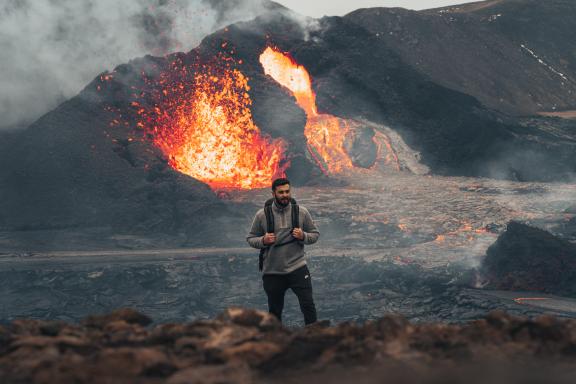
Source: Eriks Cistovs at Unsplash, 2021
One good example of an effective communication campaign around a short-term crisis was the eruption of the Eyjafjallajökull volcano in Iceland in April 2010. The eruption grounded more than 100,000 flights and disrupted travel plans for several weeks throughout northern Europe. In just three weeks, tourist arrivals to Iceland fell by 30% and continued to decline into May. Following a thorough risk assessment, tourism stakeholders predicted a tourism decline of 22% over the year and a shortfall of revenue of 180 million GBP.
Nevertheless, the Icelandic government identified an opportunity to address these significant challenges while taking the steps of preparedness and response. First, the government consolidated the Trade Council of Iceland, Invest in Iceland and the Icelandic Tourist Board under one tourism organisation, Promote Iceland, to enable close collaboration.
The newly created tourism board launched a campaign entitled ‘Inspired by Iceland’, which aimed to depict Iceland’s beauty, highlight the friendliness of the people and strongly promote the idea that Iceland was ‘open for business’. The campaign involved Icelandic nationals, encouraging the whole population to post positive messages, images and videos about their homeland.
The campaign was very successful. Across social and digital media, more than two million stories were seen and sent and, between July and August 2010, live webcam footage of Iceland generated 60 million views. 80% of posts demonstrated positive attitudes towards the country. As a result, tourism was boosted significantly and, between May and the year-end, tourist arrivals exceeded revised forecasts by 27%. Growth in the following year was sustained, and arrivals grew by 15.7%, and the Recovery has continued positively ever since.
4. Follow these four steps to respond to a crisis
Once a company is in the middle of a crisis, the first thing to do is to understand the situation as best you can and calculate the impact it can have on your organisation. This is an ongoing process as the nature of crises are always dynamic, and the consequences for your business are too.
The COVID-19 pandemic is an example of a crisis that brought businesses in all sectors to a halt all around the world. It affected the economies of countries because of job losses, revenue depletion, lack of business and insecurity regarding the future.
In the chart below, you can see how crises dominate the environment, first and most seriously affecting the economy. This leads to a loss of income to the industry, which affects your business.
Figure 3: Understanding the Situation and Putting it into Perspective
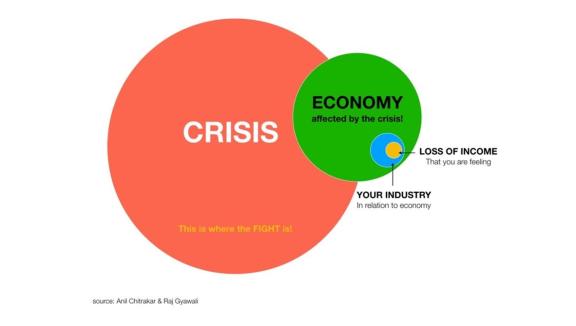
Source: Raj Gyawali, 2020
Other crises like earthquakes, mudslides and tsunamis tend to be localised events and do not affect the rest of the world. Although the immediate effect on your business might be similar to that of a global crisis, the way you strategise to react to it will be drastically different.
There are four main steps you go through during a crisis (see Figure 4). This four-step process is one of the easiest to understand and clearest to follow:
- Mitigation: Immediate actions to take to save your business just as the crisis hits.
- Preparedness: Prepare your organisation to face the current crisis and focus on working on the next two steps.
- Response: Respond to the crisis and utilise all the available resources to tackle and respond effectively.
- Recovery: The road to recovery is to prepare and work on strategies to get back to normal and beyond.
Figure 4: Tourism crisis management process
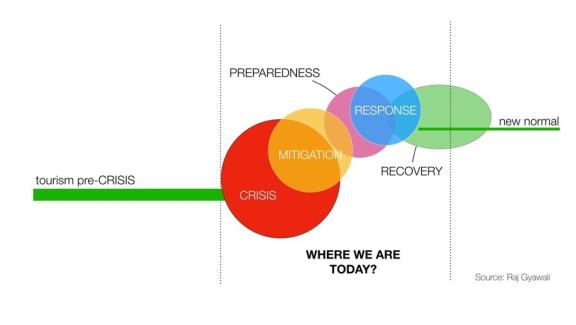
Source: Raj Gyawali, 2020
Important: Over and above these four stages is the crucial element of communication. How you communicate and what you say changes as you move from step to step. It depends on what audience you address; teams, suppliers, stakeholders, industry or the market.
We will now analyse each step in more depth.
Mitigation
Mitigation refers to the initial actions that need to be done when the company is directly in the face of a crisis or an emergency. These are the first steps that need to be taken to protect the ones in the immediate line of fire: teams, customers, suppliers, industry partners and finances.
Use this checklist to help make an immediate plan.
Table 2: Mitigation: first steps
| People | Actions |
| Team |
|
| Tourists |
|
| Suppliers |
|
| Industry partners |
|
| Finances |
|
| Communication |
|
| Leadership style |
|
Source: Acorn Tourism Consulting, 2024
Preparedness
The mitigation stage of crisis management could be a very short or long-drawn process, depending upon the immediate effect of the crisis on your business. At the same time, the process to start preparing the business for this particular crisis is important to the next stages of Response and Recovery. There are several key things to focus on at this stage.
Prepare an Emergency Response Plan
There are two parts to the Emergency Response Plan. These do not have to be major documents, but they should be flexible so they can be referred to quickly and are easy to update:
- A Response Plan – this looks at the short-term, medium-term and long-term strategies to overcome the crisis.
- A Recovery Plan – this looks at how the business re-starts itself once recovery has started.
The strategies in these documents should cover financial management, personnel management, office management, marketing and communication strategies that address the issues mentioned below. You should refer back to these plans at regular intervals as you move through the preparedness step and during the two following steps of Response and Recovery. The Emergency Response Plan is referred to as your ‘go-to plan’ throughout this study.
Assess the financial health of the company
In every crisis, there is a period of staying put and waiting for the crisis to be over. The capacity to get over the period depends on how financially secure the business is. This means how much money the organisation has when the crisis hits and how frugal it can be following the crisis. You should understand your current business cash flow and projected income forecasts well so you can plan how your finances can adapt to the crisis.
Make careful financial decisions. It is important you do not cut back on all your expenditures without thinking about your staff and business as a whole. Businesses should never forget that they are a part of an ecosystem and that working together within that ecosystem is important, particularly during difficult times.
Tips:
- Do a quick cash flow analysis to check the financial status of the company. Keep future recurring payments like salaries and rent in mind.
- Review the cancellations and refunds policy to see if it meets the requirements of the changed scenarios presented by the crisis. If you make any changes, make sure you update the terms and conditions on your website and advise on social media.
- Do multiple scenarios of the Cash Flow Analysis to help understand how it will play out if the crisis lasts a short time or a long time. The scenarios to be looked at are the best-case all the way to worst-case scenarios, calculate how long the company can survive, and where the pressures points for cash are. This will provide you with a clear idea of how to mitigate and respond to these financial pressures.
- Check out this article on Brixx.com on how best to use Cash Flow Analyses in the short, medium and long term.
Adopt a decisive leadership style
The leader at this stage is decisive, commanding, authoritative, transparent and strategic. This will ensure that things get done, and preparation is key to success in a crisis.
Work to boost team spirit
One of the first things to be affected during a crisis is team spirit or morale. Crises always cause stress. If your team is not able to work together, it can exacerbate the problem and cause the team to splinter and break. The team needs to be kept together; otherwise, important work will not happen at all.
Tips:
- Arrange regular team meetings, even if they are virtual. Concentrate on openness, and make the meetings safe spaces to express concerns and look for support. Be understanding and supportive during these meetings.
- Empower small teams to focus on specific responses, such as the development of marketing material, communications or financial responses.
- Make reporting back to the whole team essential and keep communications transparent.
- Lead the communications in the team and concentrate on keeping spirits high.
Enable working from home
COVID-19 led to the need to work from home, which has now become much more common. Working from home meant businesses have to use technology to adapt fast. Use these checks to see how ready you are:
- Can everyone be communicated with even if they are not available to come to the office?
- Can you access your server files remotely?
- Does everyone in the team have the communication tools they need to get in touch and are they trained to use them?
Many tools required to work from home may already be in place, but you should continue to check they work effectively. These are some of them:
- Microsoft Teams – the meetings and messaging app of Microsoft Office 365 (which also includes Word, Excel, Outlook and PowerPoint). Teams is widely used around the world today and can also be used free.
- Skype Conferencing – part of Microsoft, Skype provides video conferencing for groups.
- ZOOM – Zoom is similar to Teams for video conferencing. There is also a free option.
- Google Meet – is Google’s video conferencing platform.
- Google Drive – allows you to store and share files and folders in the cloud. OneDrive is Microsoft’s version.
- Slack – a productivity and communication platform.
- Trello – project planning tool for teams to collaborate on.
- WebEx – an open-source communication tool
During a crisis, set up an alternative method for communicating with your team, and make sure your staff are aware and comfortable working in this way. Provide training and keep them up to date with any changes to your communication methods so communication issues during crises can be avoided.
Check in with all of your stakeholders
To realign your business, it is critical that you do a quick stakeholder analysis, making sure that no one is left out. Refer back to the stakeholder list that you created as part of the Risk Management Process. The confidence of these stakeholders is critical to your success once the crisis is over. Make sure that you are in touch with them at all points in time.
Prepare a communication plan
Communication is an ongoing process throughout the entire period of crisis management. In the Preparedness stage, you should work on a communication plan that can be used during the Response and Recovery stages. The communications you send to different audiences and the channels you use have very specific purposes. You should define and fine-tune your communications processes on an ongoing basis.
Do not over communicate; remain factual and to the point. Do not create expectations without a solid foundation for doing so.
Develop communication templates to cover communications to suppliers, teams, agents, international partners and customers. Each one should be aligned with what you would want to tell them at this specific point in time. Use the experience gained during each communication stage to develop strategies and plans at further stages.
You can find some example templates of communication plans here.
Figure 5: Work together to deal with a crisis

Source: Annie Spratt on Unsplash, 2018
Response
Most of the crisis management lies in the response. All the preparation you have done to protect the company and its assets will help you in the response stage. While you respond to a particular crisis, remember that the crisis is still ongoing. You still have to mitigate and realign your actions to deal with other factors that may still arise. Allow time for that too, as the response depends on it.
Be productive in ‘downtime’
Some crises create ‘downtime’ for teams. Keeping your staff busy helps keep spirits up so they do not focus too much on the crisis or become too stressed. Being busy also gives them a sense of achievement, which is a great tool to relieve stress. For your business, it justifies continuing to pay salaries, and you may manage to get things done that you never had enough time to do before.
Choose tasks that will make the company better in the future. Refine your processes, fine-tune communication mechanisms, and learn new skills. You should understand, however, that downtime means that the same amount of work might not be achieved as during usual times.
Examples of work you can do during downtimes include:
- Reassess your online filing system. If it is not stored in the cloud, consider signing up for Google Drive or Dropbox.
- Make sure that you are GDPR compliant. Consult the CBI study What requirements must tourism services meet to be allowed on the European market for more information on complying with GDPR.
- Keep in regular communication with partners, clients, agents, suppliers and other stakeholders of the business. Diary up weekly or bi-weekly email updates.
- Check the details of all your trips and tours or other travel products. Make sure they are all up to date and refine/improve the content
- Review, assess, categorise and manage all your promotional materials and assets. These include written content, photos, videos and customer reviews. You can use Excel spreadsheets to keep directories and databases of your assets.
- Update your website and social media platforms regularly. If you do not have a website, consider building one. Use the CBI study How to be a successful tourism business online to help you.
Tip:
- Ask your team to make a list of things to do during downtime. Help them refine the list and agree with them on tasks to be completed. This will give them a sense of ownership.
Fine-tune market intelligence
Crises have a way of giving everyone the same chance to succeed. How well you succeed depends on how quick you are to understand the situation and can adapt to the new normal. The most important thing to do is to ensure that you remain well-informed at all times. You need to use your expertise to react at the right time when the crisis begins to ease and there is improved access to your markets again.
Develop your market intelligence gathering tools as follows:
- Research online webinars and trainings that suit your organisation. Try out a few to find the ones that are the most suitable. Assign specific members of the team to learn from these. There are many free webinars and training sessions online these days.
- Hold regular intelligence meetings to share information with the whole team.
- Check government travel advisories of your source markets, like the United Kingdom Foreign Office travel advice website. Advisories will impact decisions to travel, as will European tour operators cancelling trips and being able to get travel insurance.
- Make sure you are aware of any restrictions that your government may have placed on inbound visitors.
- Personally commit to learning more about the present crisis and its effects. Keep your staff informed about what you learn. This also ensures that the whole team remains similarly informed about the crisis.
Be adaptable and flexible
Any sort of pressure on the organisation offers a chance to assess how easily you can adapt or respond to changing market scenarios. Diversifying your offer is an important way to adapt. A good example during the COVID-19 crisis was the opening of a huge market for virtual tours. Many tour operators went ‘virtual’ and continue to offer virtual tours now that the pandemic is over. See this example of a virtual tour of Machu Picchu in Peru.
Every crisis opens up opportunities for new businesses, and companies that can be flexible and adaptable will benefit the most. Many companies suffer when they only rely on well-established systems. Flexibility is a powerful tool for companies responding to crises.
Tip:
- List potential changes that could be made to your tours, carefully considering how the market reacts to the crisis. Prioritise one or two and try them. For the ones that are successful, carry it on during the response stage and, if the markets allow it, continue it into the recovery stage.
Prepare your financial response
One of the biggest concerns in times of crisis is a company’s finances. If business comes to a standstill, as it did for many businesses during the COVID-19 pandemic, this can be very damaging for your company’s cash flow and overall financial health. The longer the crisis goes on, the worse the situation can become. You must continually assess your organisation’s finances.
Importantly, one of your biggest recurring costs will be salaries. Your first thought may be to cut salaries as staff are working less. However, this is a fine balance. Remember that your staff also hurt during the crisis, and you will need strong, motivated teams to move the business forward once recovery starts.
Tips:
- Re-examine the cash flow scenarios you created during the preparedness stage and keep fine-tuning them.
- Review your costs and see where savings can be made, for example, rent, leases and monthly bills.
- Talk to all suppliers to see if any renegotiation is possible. Keep in mind that they are also impacted, so be flexible. In the long term, it is very important to have a healthy supply chain.
- If you need to reduce staff numbers, stay in close communication with your teams so they are fully aware of the situation and colleagues losing their jobs does not come as a major surprise.
Communicate decisively and honestly
How a company communicates with its stakeholders has lasting consequences for future recovery. Most importantly, communication at this stage should be informative, professional and there should be no over selling. The main aim is to stay in contact and keep information flowing.
Your leadership style must be decisive, rational, informative and clear. Your staff are likely to be confused and worried – they will look to you for honesty. At the same time, you should be open to innovation and ideas.
Tips:
- Consult reliable sources that offer the most up-to-date information about the crisis. Refer to your government website, the National Tourist Board, newspapers and other reliable sources. Network with your peers too – they may have access to more information.
- Keep in touch with all your stakeholders with the most current information. Make sure you date all your communications to keep them relevant.
- Always respond to any queries promptly and honestly. Never make promises that you know you cannot keep. Remember to be honest, factual, reliable and reassuring.
Recovery
It is difficult to know when the Response phase becomes the Recovery phase. However, while you are on the road to Recovery, you should continue to follow what you set out in the Emergency Response Plan. As in the previous steps, you should be continuously refining and updating the plan based on the current situation. Flexibility during the Recovery phase continues to be important. Your organisation may look different following all the changes you may have made because of the crisis.
There are several points to note as you progress through the Recovery step:
- The markets may have changed, and there may be other changes in tourism processes. For example, during COVID-19, many countries imposed additional health checks on incoming visitors, and this continued for many months. You might have to adapt your company processes to the ‘new normal’.
- Your team might have changed. You may have more or less staff, or their roles may have changed. Continue to carry out more team building to make things work.
- Digitalisation continues to evolve, even during a crisis, so you should make sure you are keeping up with digital trends and new technologies to help you in the Recovery phase. The CBI study Tips to go digital will help you do this.
- Being flexible and adaptable will help at this stage as the markets will not have stabilised. Being able to respond quickly to and implement required changes will ensure that you are able to take the best advantage of the situation.
- Your stakeholder base might have changed, so developing new partners might be essential. For example, some of your suppliers may have gone out of business, and you will need to find new ones.
- Keep your Emergency Response Plan somewhere you can easily find it. It should be considered a crucial part of your business planning and one that can be used again in future crisis situations.
It can take a long time to recover following a crisis, and it will take a lot of hard work, determination, and dedication to put your business back on track.
Crisis Example 4: Immediate response to deal with a crisis – Shark Attack in the Whitsundays, Australia

Source: Zhimai Zhang at Unsplash[A2] , 2019
In 2019, two British tourists were attacked by a shark in a popular snorkelling and diving location in the Whitsundays islands. Both tourists survived, although one of them had his foot bitten off. There have been shark attacks in the area before, although they are rare. Shark attacks attract considerable international and national media attention. Being able to deal with crises immediately to mitigate negative coverage was essential to tourism stakeholders. Here is what they did.
Immediate response (1–2 hours)
- Tourism Whitsundays CEO and the Mayor of Whitsundays provided immediate comments to the media at the location.
- The first messages focused on the concerns of the injured and the provision of trauma counselling for others involved in the rescue.
Messaging response (2–6 hours)
- To ensure messaging was coordinated, Tourism Whitsundays liaised closely with stakeholders, including tour boat operators, local councils, tourism organisations and other relevant stakeholders.
- They reemphasised concern for the injured and praised the quick reactions of the emergency services.
- More media interviews were given to British and Australian news outlets.
Ongoing response (Days 2 and 3)
- The tourist board held a second media conference that focused on visitor safety. They announced they would immediately collaborate with other partners to find a long-term solution.
- Messaging was provided to tour boat operators, tourism providers and trade industry partners to ensure a unified voice in terms of visitor safety in response to visitor concerns and the media.
The results
- By addressing and handling the reporting of the incident quickly and honestly, the reporting was less sensational and more respectful towards the injured tourists and other guests.
- By actively offering solutions to the problem, there was less media speculation and criticism in the press.
- These measures helped to reassure visitors and tourism operators that measures were being taken to address safety concerns.
Acorn Tourism Consulting Limited and Social Tours carried out this study on behalf of CBI.
Please review our market information disclaimer.
Search
Enter search terms to find market research
